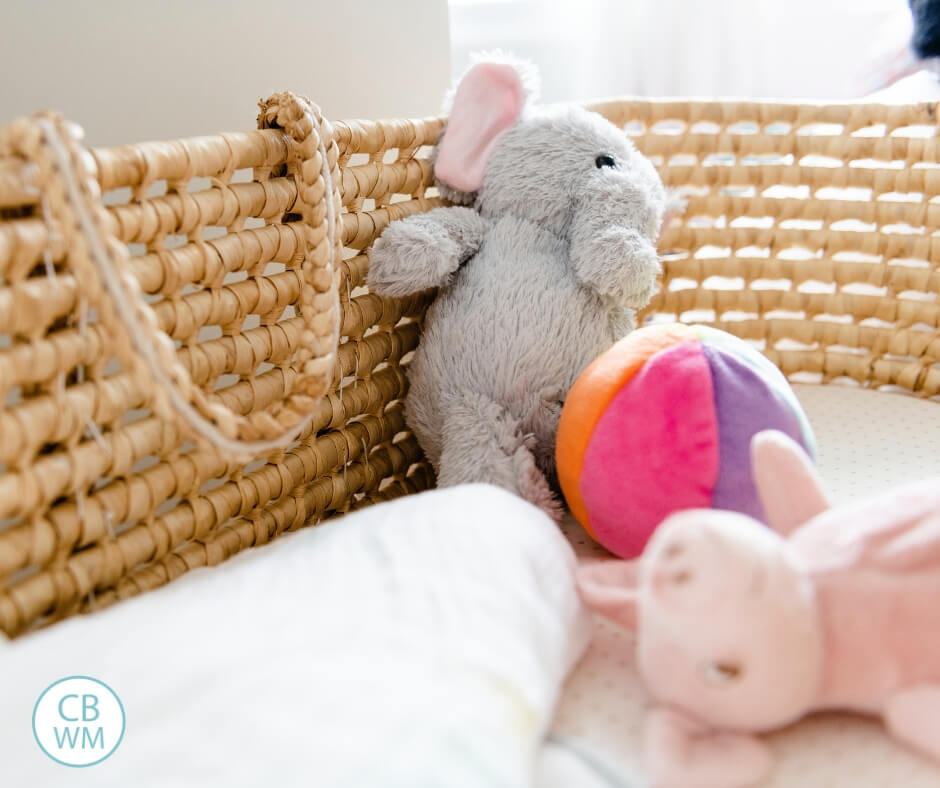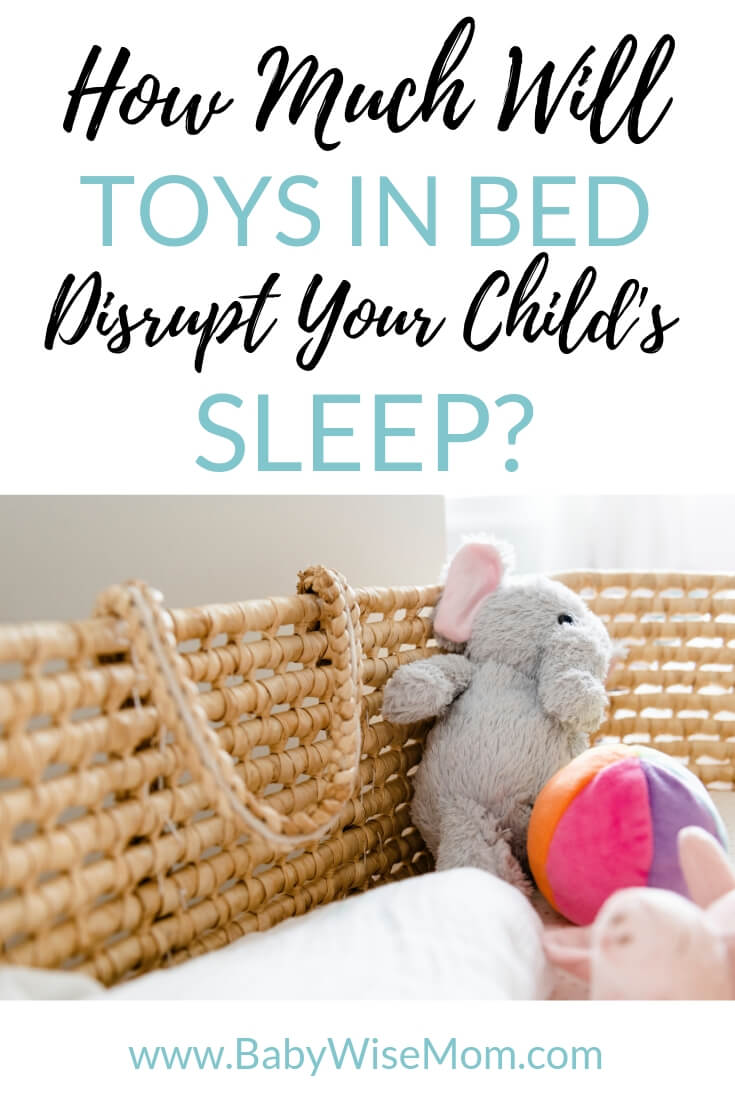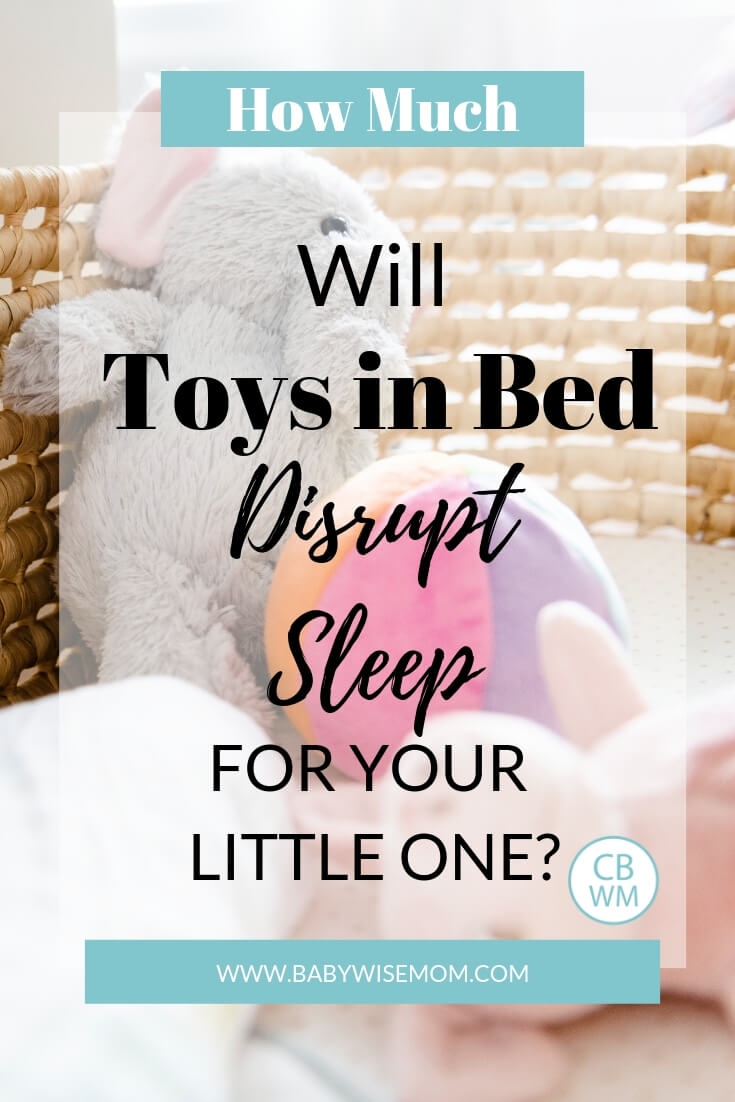Will Toys in Bed Disrupt Sleep. What ages toys might be okay for your little one. Tips to know if giving your little one toys in bed will help or hurt baby sleep.

Every so often, I get a question about the appropriateness of toys in bed. As in most things with parenting, this depends on your child. Not only does it depend on your child in general, but it depends on your child at the moment. At some stages, toys are a distraction from naptime. At other stages, they are something that seem to help naptime happen.
Post Contents
Can Your Child Have Toys In Bed
Let’s discuss the various ages of children and whether or not toys might be harmful in bed.
Young Babies
As a newborn, your child should not have any sort of toy in bed. Toys can be a hazard for little ones. You want to keep the crib free from objects.
According to the American Academy of Pediatrics (AAP), loose articles in the bed can lead to sudden infant death syndrome and can greatly increase the risk of SIDS. You want to follow safe sleep practices.
Even crib bumpers can be unsafe at this age. So while you avoid loose bedding, you also want to avoid plush toys and fluffy items.
You might have a mobile above the bed. If so, be mindful of the possibility that the mobile could distract from sleep. Some babies might look at it and get overstimulated or be so interested in it that they miss the sleep window. Others might look at it and peacefully slip into slumber.
My oldest two children had a mobile as young infants. It wasn’t a problem for either child. Our mobile had very mild colors. It also was just a mobile; it doesn’t move or make music at all. If your mobile does move and/or play music, I would caution you against turning it on for naptime or bedtime. You don’t want your child to become dependent on it for sleep.
Read: When Sleep Props are Okay and When to Avoid Them
You want to be sure you take the mobile down once your child can reach it. Brayden only had it for a couple of months, but Kaitlyn had it for quite a while (though I can’t remember exactly how long).
Older Babies
You might put a stuffed animal in the bed with your baby. I did this with Brayden around 6 months. It was a lovey for him. You want to wait until your baby can move from front to back and back to front easily and unassisted.
If you do this, be sure it is a safe stuffed animal with no parts that can come off and be choked on (like buttons or hard eyes that could be pulled off).
You will want something with soft materials.
We used stuffed animals are “friends” or “loveys” for my kids. They have never been a distraction for sleep. Both of my kids would go to sleep without a problem once they had a friend in bed. When they woke up, they would “talk” to the “friends.”

12-24 Months
This is an age when any sort of toy in the child’s sleep space can really start to become a distraction for some pretoddlers and toddlers. My kids still had stuffed animals in this age range.
Kaitlyn liked to hug one sometimes as she fell asleep. She didn’t ever play with them before sleep. We had to set them up so they are all sitting along one crib rail. Then she went to sleep. When she woke up, she would play with them and talk to them. If I went in to get her right away, she would be disappointed because she wanted to play with her babies.
When we moved Brayden from the crib to his twin bed, I was really glad he had his “friends” that he was familiar with. When we moved him, he moved beds and bedrooms. I was glad for him to have something familiar to sleep with. We plan to move Kaitlyn this month sometime, also, and I am sure her babies will help with a smooth transition.
Also, Brayden had a love for one of his “friends” in particular. When he had his surgery when he was three, he was able to take that friend in the operating room with him. They bandaged his stuffed animal up just like Brayden was bandaged. His bond with this stuffed animal helped him through this scary process.
2-3 Years Old
You can continue with the special friends. You might also start to think about something like a toy car for your child to play with or a book or two to read. If you do give him something, pay close attention to what happens. He might play with it for a few minutes then drift to sleep. But he also might play with it so long it takes him past his second wind and prevents sleep from happening.
3 Years and Up
During the third year, your child will start to drop the nap some days. Throughout Brayden’s fourth year (ages 3-4), we had to vary what did and didn’t go in his bed. At the beginning of his fourth year, he had nothing in bed with him for naps except for a blanket and pillow. That helped him to sleep better. As the year went on, he started to not sleep well for naps. So we gave him one to two cars and a couple of “friends” for a nap. That again got him sleeping well.
When he was 3.5-4 years old, he moved more and more toward rest time rather than nap time. He had one or two cars, his friends, and a few books. Some days he slept, others he didn’t, but during his nap or rest time, he was quiet and stayed in bed without a problem.
Read: Dropping Naps: Moving To Rest Time
Toys in Bed Tips
No matter the age of your child, whether or not toys are in bed with him is up to you to decide. There is no “rule” that says it is always okay or always not okay (other than those first 6 months). If you see toys are a problem, remove them. If you see toys help naptime go more smoothly and happen, use them. Here are a few guidelines I would use:
- Delay Introduction of Toys in Bed: I would wait until you see a need for a toy in bed before you ever introduce it. Putting it in earlier than the child is able to handle it is akin to giving a freedom too soon. If it turns out the toy is a hindrance to naptime, your child might be really upset when you take it.
- Analyze All Angles: Before trying the toy in bed, be sure you analyze all other possible reasons for poor naps. You don’t want to offer a toy when what your child really needs is more waketime. See sleep problems and The Cornerstone for Good Naps for help in this.
- Keep the Quantity Low: Your child doesn’t need every beloved toy in bed with him. A couple will suffice.
- Take Note of Effect: This might be a good time to keep a log. Before you give the toy, keep a log of how long it takes him to fall asleep and how the nap goes. After you give the toy, do the same. Then you can concretely see if it is helping or hurting.
- Pay Attention: If the toy helps, pay attention to watch for it to become a problem. It can. If the toy becomes a distraction, remove it.
- Avoid Props: I would avoid letting this become a prop. I would rotate toys if needed to ensure that your child will not be particular about which toy, book, or stuffed animal he has. I like to have my children able to sleep so that wherever they are, they can go to sleep. I don’t want to have to remember to pack certain toys or items to help them sleep. If we are at Grandma’s, I grab a stuffed animal she has there. Even though my kids have had the same stuffed animals for basically their entire lives, they are fine with having different ones. Monitor your child so you don’t create a prop.
Conclusion
When deciding what is best for your child, always pay attention to the results of what your child is doing. Remember your hierarchy of goals and work toward the end-goal. Read up on My Sleep Hierarchy for Newborns , Sleep Hierarchy: 3-6 Months, and Sleep Hierarchy: 6-9 Month for guidance on sleep goals.

